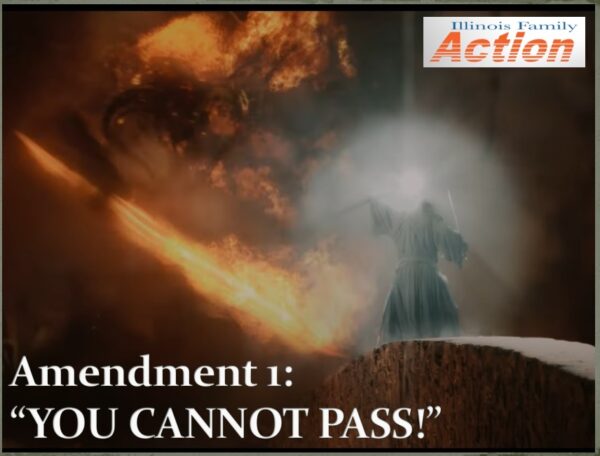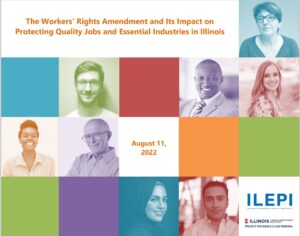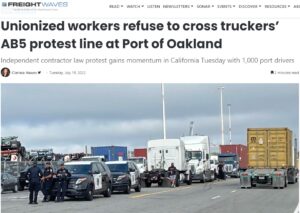
Fallacy of Proponents of Amendment 1 Exposed with Illinois History of the Past 75 Years
Written by John Lopez
This article addresses a ballot measure that Illinois voters must vote on this election cycle.
We urge voters to reject Amendment 1, a constitutional amendment that
would elevate collective bargaining rights in the Illinois Constitution,
allowing government union contracts to override state law.
The organized labor movement helped to build the United States of America to be the greatest country in the world.
Once workers were protected with laws many take for granted today, like the 40-hour work week, overtime pay and the ability for front line workers to organize, the American middle class was established and thrived through most of the 20th Century.
The core mission of the labor unions which represented workers during the heyday of unions through the 1960s is two-fold:
- Collective bargaining
- Contract administration
Workers, to achieve a collective bargaining agreement, have the right to strike, and settlements between management and labor were won, and then implemented in partnership, respect and cooperation between management, labor union leaders and the rank-and-file union members.
As recent as July of 2022, worker solidarity can still bring tears to one’s eyes. The Port of Oakland, CA, was shut down by independent truckers protesting a California law which eliminated their right-to-work as independent contractors.
With the truckers and their tractor-trailer rigs blocking ground access to the Port of Oakland, the International Longshore and Warehouse Union local, in the midst of their own contract dispute with the Port, joined the truckers protest and honored the truckers protesting not the Port, but the state of California over an unfavorable labor law that was written, and implemented to benefit and build union membership.
Sadly, the California example is worker solidarity in its purest form and is few and far between today with the political polarization plaguing the United States.
Over the past 50 years, labor unions and their leadership strayed from the core mission of collective bargaining and contract administration, and sought to become involved in politics.
This started in the 1970s, and with the help of organized labor, James Earl “Jimmy” Carter won the presidency of the United States in 1976. Four years and record-setting inflation later, Ronald Reagan defeated President Carter in 1980.
The “Reagan Democrats” greatly contributed to Reagan’s win. Primarily from the Midwest, the Reagan Democrats were predominately rank-and-file union members who refused to listen to their union bosses, and chose to vote for their future, not what unions wanted.
The Reagan Democrats showed themselves again, after successful prosperity including rank-and-file union members keeping more of their hard-earned tax dollars, President Reagan was reelected to a 2nd term with a 49-state sweep.
By the mid 1980s, unions were a bad name to many middle class voters. The author recalls, theater performances where the actors represented by a union local had to be recognized publicly by the theater at the end of intermission, audiences would boo their disapproval of unions.
Unions, due to their leadership, have become distorted and strayed from their core mission as their power grew in the Democratic Party. Now this power threatens many workers across occupations and industries.
On November 8, 2022, the Illinois General Election Ballot will include at the very top a constitutional amendment concerning Labor known as “Amendment 1”
 Billed as the “Workers Rights Amendment” by its proponents, particularly within the publication from the Illinois Economic Policy Institute and the Project for Middle Class Renewal, University of Illinois at Urbana-Champaign titled “The Workers’ Rights Amendment and Its Impact on Protecting Quality Jobs and Essential Industries in Illinois” published on August 11, this response will urge a “NO” vote on Amendment 1.
Billed as the “Workers Rights Amendment” by its proponents, particularly within the publication from the Illinois Economic Policy Institute and the Project for Middle Class Renewal, University of Illinois at Urbana-Champaign titled “The Workers’ Rights Amendment and Its Impact on Protecting Quality Jobs and Essential Industries in Illinois” published on August 11, this response will urge a “NO” vote on Amendment 1.
The reason for the “NO” vote is simple, and 3-fold.
It is the honest opinion of the author of this response Amendment 1 should not pass for the following reasons:
- Current Illinois law already guarantees the freedoms the proponents say are needed through passage of Amendment 1
- The proponents present their case focusing heavily on labor unions and not the workers across Illinois or the changing economy for workers choices and entrepreneurships which no longer need representation through a labor union
- With the current organized labor movement within Illinois, other states and within the current Administration and the United States Congress, the risks for all workers under the current Amendment outweigh the benefits proponents claim
Finally, all workers freedoms can be protected through a holistic approach to reforming current labor law at the national level and within the state of Illinois without the need for a constitutional amendment. As witnessed at the Port of Oakland in July where 1099 independent contractors and rank-and-file union members stood side-by-side, so can all stakeholders work respectfully together to build the long-term solution to ensure workers rights, while protecting the American workers’ freedoms within and outside of a labor union.
The language of Amendment 1:
Employees shall have the fundamental right to organize and to bargain collectively through representatives of their own choosing for the purpose of negotiating wages, hours, and working conditions, and to protect their economic welfare and safety at work.
No law shall be passed that interferes with, negates, or diminishes the right of employees to organize and bargain collectively over their wages, hours, and other terms and conditions of employment and work place safety, including any law or ordinance that prohibits the execution or application of agreements between employers and labor organizations that represent employees requiring membership in an organization as a condition of employment.
The Amendment’s language reads like basic, common sense which should already be in place.
Applying discernment, common sense shredded and a hidden agenda revealed.
Fact of the matter, everything in the first sentence of Amendment 1 already exists in Illinois. No constitutional amendment, or any new law, needed because Illinois workers already have the fundamental right to organize and bargain collectively.
The emphasis of Amendment 1 is the 2nd paragraph, particularly
“No law shall be passed that interferes with…”
The proponents, in the August 11 ILEPI publication, recounted the history of the organized labor movement, including:
- Passage of the National Labor Relations Act of 1935
- Passage of the Taft-Hartley Act of 1947
Because of the angling of the ILEPI publication, additional historical context offered in order to bring balance to the important references of both National Labor Relations Act and Taft-Hartley Act.
In the mid-term elections of 1946, Republicans took control of both houses of Congress for the first time since before the Great Depression and World War II. Being 15 years out of power, Republicans, in spite of Democrat President Harry S. Truman in the White House, were ready to pass some Republican policies, including dealing with the excesses, in their opinion, of the National Labor Relations Act (NLRA) of 1935, sometimes known as the Wagner Act, one of President Franklin D. Roosevelt’s New Deal programs.
The result of the 80th Congress was the Taft-Hartley Act of 1947 which passed both houses of Congress, and was vetoed by President Truman.
Majority Republicans, with help from southern Democrats, successfully voted to override President Truman’s veto, and Taft-Hartley amended the NLRA, which included states being allowed to pass right-to-work laws.
Currently, there are 28 states (Ohio has an opt-out to prohibit unions from compelling workers dues for political activities, and opt-out members only pay an agency fee for dues), plus the territory of Guam, which have right-to-work laws on the books to protect workers from forced unionization as well as coercion, mau-mau or other forms of intimidation unions have a history to employ to organize as well as labor disputes.
All of Illinois neighbors have passed right-to-work laws, most in the past 10 years:
- Iowa, 1947
- Indiana
- Passed and implemented 1957
- Repealed 1965
- Passed and implemented 2012
- Michigan, 2012
- Wisconsin, 2015
- Kentucky, 2017
- Missouri
- Passed in 2017
- Rejected by voters in 2018
- Never implemented
Many opponents of right-to-work state laws like to trace their origins to the Jim Crow south, and admittedly it would be intentionally naïve to believe there was no racist motivation contributing to the southern Democrats to contribute their votes to override President Truman’s veto of the Taft-Hartley Act of 1947.
The passage of Taft-Hartley by the override of President Truman’s veto turned 75 in mid-June.
Over the past 10 years in the 21st Century, midwestern states along with border states (including West Virginia in 2016) have passed right-to-work laws.
The motivation of Illinois’ neighbors cannot be blamed on the Jim Crow south.
The move to right-to-work state laws by Illinois’ neighbors in the past 10 years can be traced to the distortion of unions from their core mission of worker representation, into the spoiling of union leadership by the rot of gaining power to control the livelihoods of millions of Illinois residents, and American workers.
But most importantly, in the 75 years since Taft-Hartley’s passage, there is no political will to implement a right-to-work law in Illinois. None.
Even when Republicans controlled both houses of the Illinois General Assembly and the governor’s mansion in the mid 1990s, no one brought up, let alone advanced, passage of a right-to-work law in Illinois.
More recently, during the term of Governor Bruce Rauner, a move to make Illinois a right-to-work state under the ill-fated “Turnaround Agenda”, as Frank Manzo, IV, executive director of ILEPI and co-author to the ILEPI proponents position paper, recently opined in an op-ed last week in the The State Journal-Register said:
“…laws have been enacted to encourage workers whose wages, benefits, and working conditions are collectively bargained — to stop paying for the services they receive from labor unions. These ‘free rider’ laws are designed to reduce the resources unions would otherwise have available to organize and support workers and have been a key factor in reducing the share of America’s workforce represented by unions — from one-in-three 50 years ago, to just one-in-10 today.
“At the time, bipartisan majorities in the Illinois General Assembly overwhelmingly rejected Rauner’s ‘free rider’ proposals.”
Clearly, Manzo’s pro-union bias self-evident, but the bipartisan defeat of the Rauner right-to-work proposal more proof, if any more needed, Amendment 1 is not needed and cannot pass on November 8.
The next article will apply discernment to the ILEPI position paper, and reveal the hidden agenda hinted in the Manzo quote above.
Feature photo credit The Bridge of Khazad-dûm, Lord of the Rings: The Fellowship of the Ring produced by New Line Cinema, co-produced by Wingnut Films, 2001, with additions by John Lopez, Policy Political Consulting
John Lopez has written about policy and elections through the McHenry County Blog since 2019 through July 2021. He is now semi-retired, and does freelance work with analytics, as well as political candidates, emphasizing policy as the means to advance the conservative message, by engaging through policy “dog fighting”, applying discernment for winning and advancing God’s Kingdom agenda.
John’s known for getting past the talking points, the narratives, the abstracts, the platitudes and the bromides in order to discuss policy and apply Scripture to overcome unholy divisions in the local community, our state, and nation. John has been married for over 17 years.
Follow John on Twitter: @MarcVAvelar













